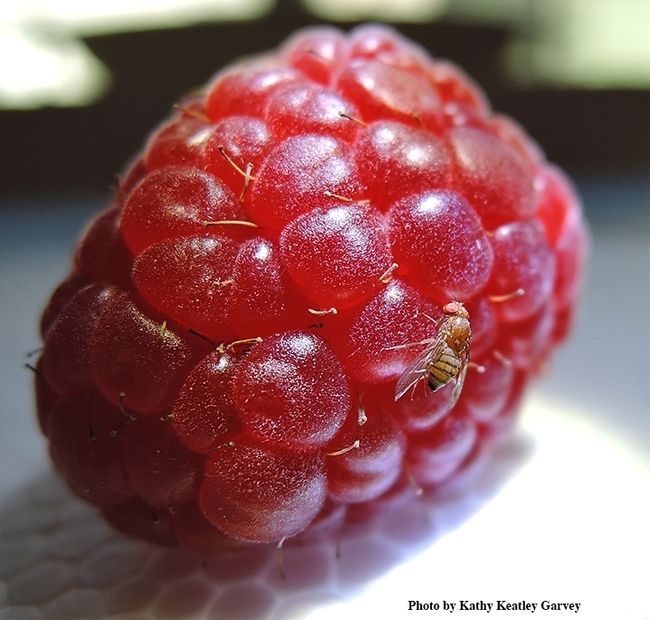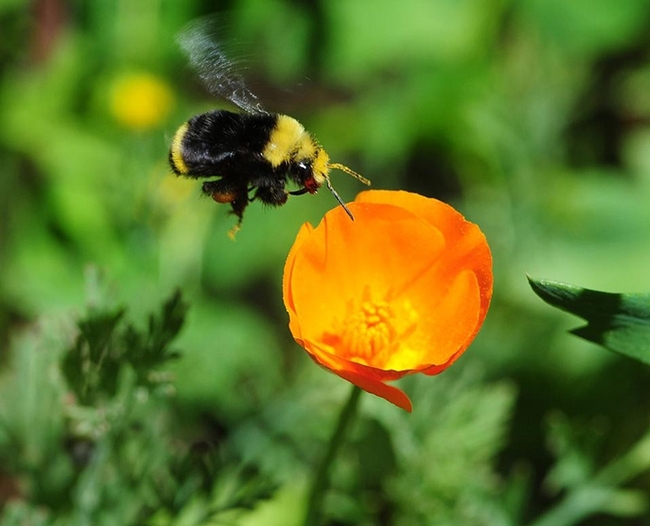- Author: Kathy Keatley Garvey

It's long been a model organism for biological research in such fields as genetics, physiology, microbial pathogenesis and life history evolution.
And now, a New York scientist is studying the circadian and homeostatic regulation of sleep in these fruit flies.
Orie Shafer, professor of biology and cognitive neuroscience, City University of New York, will share his research on Monday, Feb. 5 in a seminar hosted by the UC Davis Department of Entomology and Nematology.
Shafer will discuss "Circadian and Homeostatic Regulation of Fly Sleep" at 4:10 p.m. in Room 122 of Briggs Hall, and also on Zoom. The Zoom link:
https://ucdavis.zoom.us/j/95882849672.
"Sleep-like states are ubiquitous in the animal kingdom and are regulated by two distinct forms of regulation, circadian and homeostatic," Shafer says in his abstract. "Homeostatic mechanisms promote increases in sleep pressure during prolonged wakefulness. Circadian mechanisms determine the likelihood of sleep, increasing or decreasing its probability across the day. Though the molecular and neural mechanisms of circadian timekeeping are relatively well-understood, much less is known about the mechanistic basis of sleep homeostasis. The fly Drosophila melanogaster is a powerful model organism for the studying of sleep regulation. In this talk I will describe recent work from my lab examining how circadian timekeeping and sleep homeostasis operate in this fly and how these two regulatory processes converge to produce the proper timing and amount of sleep."
Shafer will be introduced by molecular geneticist and physiologist Joanna Chiu, professor and chair of the department. He received his doctorate in biology from the University of Washington, and served as a postdoctoral researcher at Washington University School of Medicine, St. Louis.
In a YouTube video with Abhilash Lakshman on "Circadian and Homeostatic Regulation of Sleep in an Insect Brain," Shafer points out that "Sleep is largely controlled by two processes--a circadian clock that regulates its timing and a homeostat that regulates the drive to sleep." In the video, he discusses some of the fundamental biology involved in human and fly sleep. Lakshman describes "an elegant two process model in which the circadian and homeostatic components act independently, bringing theory and experiment together for a new understanding of fly sleep."
D. melanogaster feeds on rotting fruit and fermenting beverages, and is often found not only in orchards, but in kitchens and bars.
Charles W. Woodworth proposed in 1901 that D. melanogasterbe used as a model organism. "As of 2017, six Nobel Prizes have been awarded to drosophilists for their work using the insect," according to Wikipedia. "D. melanogaster is typically used in research owing to its rapid life cycle, relatively simple genetics with only four pairs of chromosomes, and large number of offspring per generation. It was originally an African species, with all non-African lineages having a common origin. Its geographic range includes all continents, including islands. D. melanogaster is a common pest in homes, restaurants, and other places where food is served."
For any Zoom technical issues, contact seminar coordinator Brian Johnson, associate professor, at brnjohnson@ucdavis.edu. See complete list of seminars for the winter quarter.
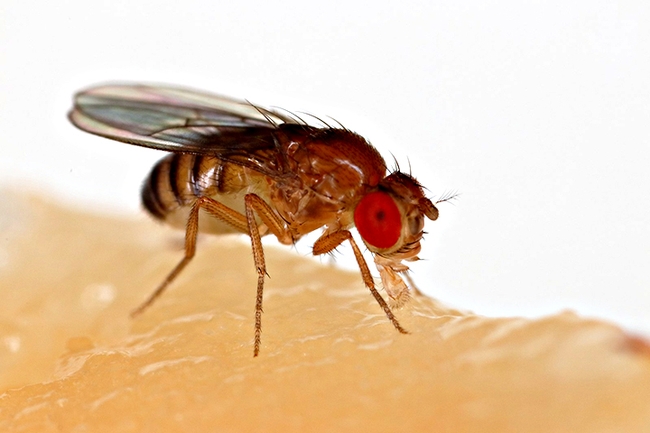
- Author: Kathy Keatley Garvey

That's true for assistant professor Katie Thompson-Peer of the Department of Developmental and Cell Biology, UC Irvine, who will speak on "Cellular Mechanisms of Dendrite Regeneration after Neuron Injury” at the UC Davis Department of Entomology and Nematology seminar on Wednesday, May 24.
She uses the larvae and adult fruit fly, Drosophila melanogaster, as a model to study dendrite regeneration.
Thompson-Peer will present her seminar at 4:10 p.m. in Room 122, Briggs Hall. Her seminar also will be virtual. The Zoom link: https://ucdavis.zoom.us/j/95882849672
Her abstract: “Neurons have two types of cellular projections, that are essential for how they function in circuits: they have a single axon and a highly branched network of dendrites. These dendrites are the cellular structures that allow neurons to receive input from the environment or from other neurons. While much is known about how axons respond to injury, almost nothing is known about how neurons respond to dendrite injury. We have found that after dendrite injury, peripheral nervous system neurons are able to mount a reliable, reproducible process of dendrite regeneration. In this talk, I present our recent work to determine how neurons detect injury to their dendrites, using the larvae and adult fruit fly Drosophila melanogaster as a model to study dendrite regeneration.”
Thompson-Peer, who joined UC Irvine in April 2019, received her bachelor's degree in biology from the University of Pennsylvania, and then followed with a two-year stint at the Johns Hopkins University with Alex Kolodkin. She earned her doctorate from Harvard University, working with Josh Kaplan, and was a postdoctoral fellow with Yuh-Nung and Lily Jan at UC San Francisco and the Howard Hughes Medical Institute. Her postdoctoral work drew financial support from the National Institute of Neurological Disorders and Stroke F32 and K99/R00 fellowships, as well as a UC Office of the President's Postdoctoral Fellowship.
The Thompson-Peer lab explores how neurons recover from injury in vivo, and how this process is similar to and different from normal development. (See her work showcased on YouTube)
"At the most fundamental level, a neuron receives information along dendrites, and sends information down an axon to synaptic contacts," she writes on her website. "Dendrites can be injured by traumatic brain injury, stroke, and many forms of neurodegeneration, yet while the factors that control axon regeneration after injury have been extensively studied, we know almost nothing about dendrite regeneration. Our long-term research goal is to understand the cellular mechanisms of dendrite regeneration after injury."
"Our previous work found that the sensory neurons in the fruit fly Drosophila peripheral nervous system exhibit robust regeneration of dendrites after injury and used this system to explore central features of dendrite regeneration in developing animals, young adults, and aging adults. We have observed that after injury, neurons regrow dendrites that recreate some features of uninjured dendrites, but are unable to reconstruct an entire arbor that perfectly mimics an uninjured neuron. Moreover, there are mechanistic differences between the outgrowth of uninjured neurons versus the regeneration of dendrites after injury: dendrite regeneration is uniquely dependent on neuronal activity, ignores cues that constrain and pattern normal dendrite outgrowth, and confronts a mature tissue environment that is different from what a developing neuron would encounter. These challenges are significantly exacerbated when neurons in aging animals attempt to recover from injury."
Department seminar coordinator is urban landscape entomologist Emily Meineke, assistant professor. For technical issues regarding Zoom connections, she may be reached at ekmeineke@ucdavis.edu. (See complete list of spring seminars.)
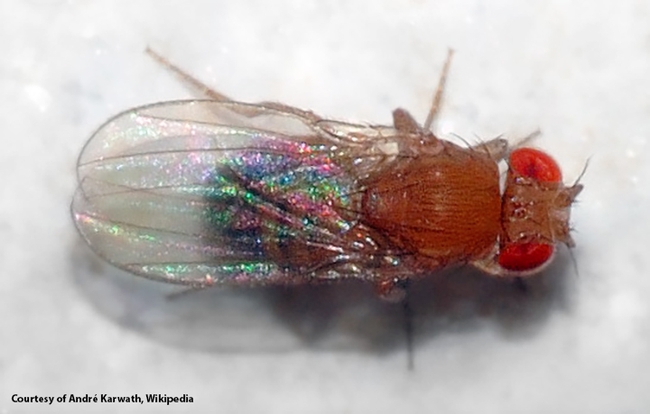
- Author: Kathy Keatley Garvey
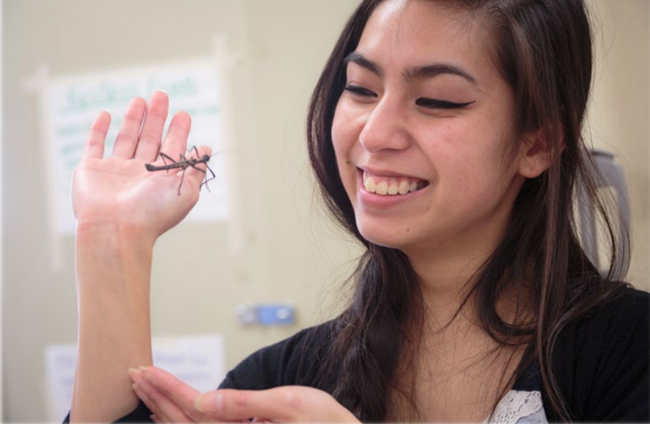
Native to Southeast Asia, it infests soft-skinned fruits such as strawberries, raspberries, cherries, blueberries, blackberries, peaches and grapes. Scientists first detected it in the United States (central coastal region of California) in 2008.
If you attend UC Davis doctoral candidate Christine Tabuloc's exit seminar at 4:10 p.m., Wednesday, Feb. 15--in-person or virtually--you'll get a grasp of the work she's doing involving D. suzukii, a worldwide pest, and D. melanogaster, a common species used worldwide as a model organism in genetics.
Tabuloc, advised by molecular geneticist and physiologist Joanna Chui, professor and vice chair of the UC Davis Department of Entomology and Nematology, will speak on "Environmental and Anthropogenic Impact on Insect Gene Expression and Physiology" in 122 Briggs Hall Her seminar also will be virtual. The Zoom link:
https://ucdavis.zoom.us/j/95882849672.
Professor Chiu will introduce her. A pre-seminar coffee session is set from 3:30 to 4:10 p.m. in Briggs 158.
"Natural environmental factors and anthropogenic disturbances can modulate gene expression, resulting in
alteration of organismal phenotype," Tabuloc says in her abstract. "In the first part of my thesis project, I used Drosophila melanogaster as an insect model to understand the mechanisms by which 24-hour light-dark cycles can regulate rhythmic changes in the chromatin to generate circadian rhythms of gene expression and orchestrate daily biological rhythms. I observed that two clock proteins, CLOCK and TIMELESS, regulate daily rhythmicity in the binding of BRAHMA, a chromatin remodeler, to DNA spanning clock-controlled genes to facilitate their rhythmic gene expression cycles. Moreover, because TIMELESS degrades in the presence of light, my results provide new insights into how light affects DNA structure and gene expression."
"In the second part of my thesis project, I investigated the impact of insecticide applications on the
fruit pest Drosophila suzukii," Tabuloc said. "Specifically, I performed RNA sequencing analysis on D. suzukii flies that are either susceptible or resistant to common insecticides to determine genetic mechanisms underlying insecticide resistance in this agricultural pest. My results revealed that enhanced metabolic detoxification confers pyrethroid resistance while
spinosad resistance is the result of both metabolic and penetration resistance. Finally, we identified alternative splicing
as an additional mechanism of resistance. These results will facilitate the development of efficient molecular
diagnostics to identify insecticide resistance in the field and enable growers to adjust D. suzukii spray programs to
control this devastating pest more effectively."
Christine received her bachelor of science degree in biochemistry and molecular biology from UC Davis in 2015. She joined the Chiu lab as an undergraduate research assistant in 2012. "Much of my work in the lab has involved different agricultural pests and investigating the molecular aspects contributing to the insect's ability to be an effective pest," she says on the Chiu lab website. "My current focus is to investigate the effects of climatic change on gene expression of an invasive pest and determine whether there is a correlation to resistance and survival. In addition to pest management research, I am also studying a kinase of a core clock protein in Drosophila melanogaster and hoping to dissect its functional contribution to the molecular oscillator."
The UC Davis Department of Entomology and Nematology's winter seminars are held on Wednesdays at 4:10 p.m. in 122 Briggs Hall. All are virtual. They are coordinated by urban landscape entomologist Emily Meineke, assistant professor. (See schedule.) She may be reached at ekmeineke@ucdavis.edu for technical issues.
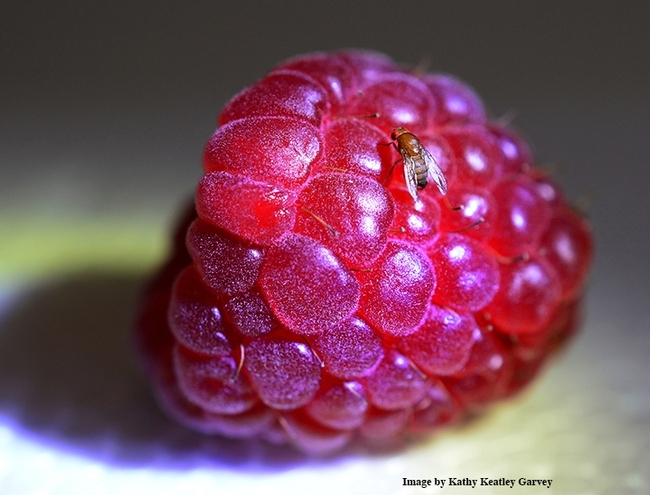
- Author: Kathy Keatley Garvey

Green Hall memorializes two outstanding scientists--Mel, a geneticist, and wife Kathleen, a biologist.
Melvin Green, who died Oct. 24, 2017 at age 101, was a UC Davis distinguished professor emeritus of molecular and cellular biology who co-founded the UC Davis Genetics Department (now part of the Department of Molecular and Cellular Biology). Kathleen, who died in 2002, was a UC Davis biologist and a longtime Davis City Council member--she was the first woman elected to serve on the council. A scholarship in her name honors women in science.
Selected the 1971 Davis Citizen of the Year, Kathleen served the community in a number of capacities, including charter member and president of the League of Women Voters in Davis, and a member of the the Sutter Davis Hospital Board of Directors.
Brilliant Scientist
During Mel Green's 60-year career, he was inducted into the National Academy of Sciences and received two Guggenheim fellowships. He inspired generations of students, faculty and staff.
We never met Kathleen, but we knew Mel as a brilliant scientist and a wonderful conversationalist, with a finely honed sense of humor. He was a frequent visitor in the halls and offices of the Department of Entomology and Nematology.

Leal and dozens of colleagues spearheaded a movement among the faculty to rename the building. UC Davis Chancellor Gary May approved the name.
"Not many know that Mel, who grew up in the Depression in a Jewish ghetto, became not only a first-generation college graduate in his family but also the first Jewish person to receive a Ph.D. in zoology and biochemistry from the University of Minnesota (1942)," Leal related. "Mel served in the U. S. Army during World War II, and then joined the UC Davis faculty in 1950. He worked until his nineties. During his lengthy and productive career, he made seminal discoveries concerning the nature of mutations using the fruit fly, Drosophila melanogaster. In particular, Mel is known for his discovery of mobile DNA elements."
"Mel would stop by my office on a regular basis just to check on me, talk science, and sometimes to tell a nice joke. For example, in October 2004 he showed up early in the morning and told me: 'Walter, you are screwed!' I asked why and he told me 'Richard Axel and Linda Buck just got the Nobel Prize for their work on olfaction.' I had a good laugh.'"
Mel connected widely and often with UC Davis entomologists, including Bruce Hammock, Hugh Dingle, Lynn Kimsey and Robert Kimsey. Lynn, director of the Bohart Museum of Entomology and a professor of entomology, identified the insect taxonomy for Mel's article, "It Really Is Not a Fruit Fly," appearing in the Sept. 1, 2002 edition of the journal Genetics.

In the article, Green pointed out that the genus Drosophila includes more than 1000 species. He argued that all Drosophila species "should be referred to by their scientific, not their common name."
Mel wrote that "real fruit flies, e.g., the Mediterranean fruit fly, the Oriental fruit fly, and other members of the family Tephritidae, attack unblemished fruit and in heavy infestations cause serious economic damage. In contrast, even if present in enormous numbers, D. melanogaster is innocuous and of no economic importance."
But to a "layperson's unsophisticated eye," the insects hovering over a fruit bowl, evoke the term, evoke "fruit fly," not "vinegar fly," the geneticist wrote.
The UC Davis campus bursts with buildings named for outstanding faculty, including:
- Asmundson Hall, named for Professor Vigfus Asmundson
- Briggs Hall,named for Professor Fred N. Briggs
- Everson Hall: Professor Gladys Everson
- Hutchison Hall: Professor Claude B. Hutchison
- Kleiber Hall: Professor Max Kleiber
- Bainer Hall: Professor Roy Bainer
And now, the list includes Green Hall, a fitting tribute to the careers of Melvin and Kathleen Green. (See UC Davis news story)

- Author: Kathy Keatley Garvey

And that's just a small portion of what they do.
And what a difference they're making!
Four UC Davis entomologists won awards from the Pacific Branch, Entomological Society of America (PBESA). They will be honored at the PBESA conference set for March 31-April 2 in San Diego.
Molecular geneticist/physiologist Joanna Chiu won the Physiology, Biochemistry, and Toxicology Award; pollination ecologist Neal Williams, the Plant-Insect Ecosystems Award; doctoral candidate Brendon Boudinot, the John Henry Comstock Graduate Student Award, the highest PBESA graduate student award; and UC Davis doctoral graduate Jessica Gillung, the Early Career Award.
Joanna Chiu is a newly selected Chancellor's Fellow, a five-year prestigious honor given to what Chancellor Gary May calls “prolific scholars, strong teachers, effective mentors and dedicated contributors to campus whose work is novel, unique and cutting-edge, groundbreaking and pathbreaking.”
Chiu investigates the regulation of animal circadian rhythms in her laboratory by using a combination of molecular genetics, biochemical, genomic, proteomic, and metabolomic approaches. Her overall research goal: to dissect the molecular and cellular mechanisms that control the circadian clock in animals, and to investigate how this endogenous timer interacts with the environment and cellular metabolism to drive rhythms of physiology and behavior.
Among the insects she studies: the spotted-wing drosophila, Drosophila suzukii.
"She has published a considerable amount on the spotted-wing drosophila, including its annotated genome, resistance studies, molecular basis of the so-called ‘winter morphs that are found in colder areas, and a molecular diagnostic for quickly providing species identification for all stages of this pest to distinguish it from other common Drosophila species," said emeritus Frank Zalom, UC Davis distinguished professor of entomology and a past president of the 7000-member Entomological Society of America.
"I can honestly say that in my 40 years on the faculty at UC Davis and earlier at the University of Minnesota, I have
never had the opportunity to work with a more collaborative and energetic early career scientist than Dr. Chiu," Zalom said.
Chiu, along with Professor Jay Rosenheim and associate professor Louie Yang of the UC Davis Department of Entomology and Nematology, are co-founders and co-directors of the highly successful, campuswide Research Scholars Program in Insect Biology. She helps students conduct cutting-edge research and provides guidance and advice, even after they have embarked on their own careers. Under her tutelage, many of her students are first authors of publications in prestigious journals.

Neal Williams "is widely known and respected for his excellence in research, extension, outreach, teaching, leadership and mentoring," said nominator Steve Nadler, chair of the Department of Entomology and Nematology. “He is a leading voice in the development of collaborative research on insect ecology. He has organized national and international conferences, leads scores of working groups, and guides reviews of impacts of land use and other global change drivers on insects and the services they provide.”
Williams focuses his research on the ecology and evolution of bees and other pollinator insects and their interactions with flowering plants. His work is particularly timely given concern over the global decline in bees and other pollinators.
Research entomologist James P. Strange of USDA's Bee Biology and Systematics Laboratory at Utah State University, describes Williams as “a valuable resource and prolific scientist in pollination biology and pollinator management. His papers are the result of collaborations with leaders in pollinator ecology, behavior and management and have been cited over 13,000 times during his career. His work has unraveled several questions central to plant-pollinator interactions, especially illuminating our understanding of the impacts of landscape resources on pollinator populations.”
In July, Williams will co-chair the Fourth International Conference on Pollinator Biology, Health and Policy at UC Davis. The four-day conference, themed “Multidimensional Solutions to Current and Future Threats to Pollinator Health,” will highlight recent research advances in the biology and health of pollinators, and link to policy implications.
Williams is also organizing a symposium at the PBESA's San Diego meeting in April on the lifelong contributions of native pollinator specialist, Robbin Thorp, UC Davis distinguished emeritus professor of entomology. Nine scientists influenced by Thorp and his research program will speak.

Brendon Boudinot, who studies with ant specialist/professor Phil Ward, was praised for his academic record, leadership, public service activities, participation in professional activities, and his publications. “A highly respected scientist, teacher and leader with a keen intellect, unbridled enthusiasm, and an incredible penchant for public service, Brendon maintains a 4.00 grade point average; has published 12 outstanding publications on insect systematics (some are landmarks or ground-breaking publications); and engages in exceptional academic, student and professional activities,” Nadler wrote.
Ward said that Boudinot, despite being at an early stage of his academic career, has already published several landmark papers on insect systematics. "This includes a remarkable article, just published in Arthropod Structure & Development, in which Brendon presents a comprehensive theory of genital homologies across all Hexapoda (Boudinot 2018). Based on careful comparative morphological study and conducted within a phylogenetic framework, this paper is a major contribution to the field and is destined to become a “classic." This could have been a decade-long study by any investigator, and yet it is just one chapter of Brendon's thesis!"
Active in PBESA and ESA, Boudinot received multiple “President's Prize” awards for his research presentations at national ESA meetings. He organized the ESA symposium, “Evolutionary and Phylogenetic Morphology,” at the 2018 meeting in Vancouver, B.C. , and delivered a presentation on “Male Ants: Past, Present and Prospects” at the 2016 International Congress of Entomology meeting in Orlando, Fla.
Boudinot served on—and anchored—three of the UC Davis Linnaean Games teams that won national or international ESA championships. The Linnaean Games are a lively question-and-answer, college bowl-style competition on entomological facts played between university-sponsored student teams.
Boudinot has served as president of the UC Davis Entomology Graduate Student Association since 2006, and is active in the campuswide UC Davis Picnic Day; he has co-chaired the department's Picnic Day Committee since 2017.
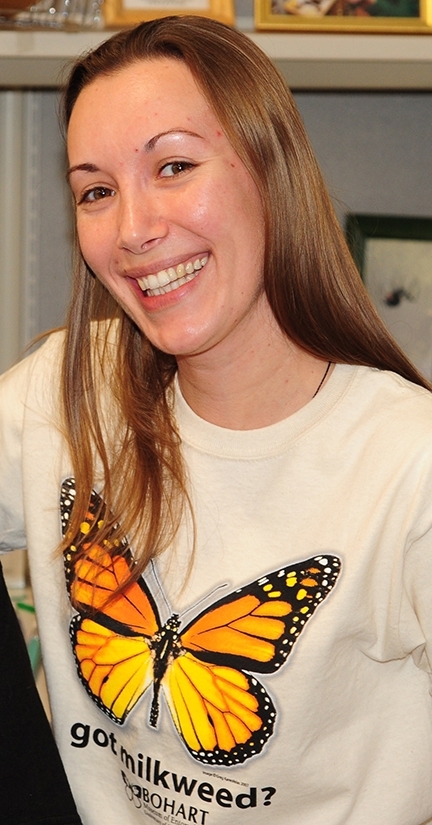
Jessica Gillung studied for her doctorate with major professor Lynn Kimsey, director of the Bohart Museum of Entomology and professor of entomology. “Dr. Gillung has made outstanding contributions to entomology, shown commitment to extension or outreach, and excelled in entomological education,” Kimsey wrote in her letter of nomination. “In one word: she is ‘phenomenal.'"
Gillung most recently won the “Best Student Presentation Award” at the ninth annual International Congress of Dipterology, held in Windhoek, Namibia, and the 2018 PBESA Student Leadership Award. Her dissertation was titled: “Systematics and Phylogenomics of Spider Flies (Diptera, Acroceridae).”
Kimsey praised her phenomenal leadership activities, her nearly straight-A academic record (3.91 grade point average), her excellence as an entomologist and teacher, and her incredible publication record. “Note that she has 11 refereed publications on her thesis organisms in very strong journals,” Kimsey wrote. “Most entomologists do not publish nearly that much, even as a postdoctoral scholar or a junior faculty member!”
"Not only is Jessica's research on the cutting edge of the field of phylogenomics but--and this is where leadership comes in--she has taken it upon herself to involve and train other graduate students in the same cutting-edge techniques and theoretical framework," Kimsey said. "She is a dynamo--brilliant and high energy, but also constantly teaching."
A native of Brazil, Gillung speaks four languages fluently: Portuguese, Spanish, English and German. While at UC Davis, Gillung was active in PBESA and ESA, presenting a number of presentations and serving on award-winning Linnaean Games teams. In outreach programs, she reached at least 20,000 people encompassing all events from 2013 to 2018. This included open houses, off-site programs, science presentations, summer camps, classroom activities, UC Davis Picnic Days, agriculture days, and fairs and festivals.
As a postdoctoral researcher at Cornell University in the Bryan Danforth lab, Gillung is researching Apoidea (stinging wasps and bees) phylogenomics, evolution and diversification.
PBESA Award Recipients
The complete list of PBESA recipients:
- CW Woodworth: Elizabeth Grafton-Cardwell, UC Riverside.
- PBESA Award for Excellence in Teaching: Allan Felsot, Washington State University
- PBESA Award for Excellence in Extension: Surendra Dara, UC Cooperative Extension
- PBESA Award for Excellence in Integrated Pest Management: Silvia Rondon, Oregon State University
- PBESA Systematics, Evolution, and Biodiversity Award: Christiane Weirauch, UC Riverside
- PBESA Physiology, Biochemistry, and Toxicology Award: Joanna Chiu, UC Davis
- PBESA Medical, Urban, and Veterinary Entomology Award: Rebecca Maguire, Washington State University
- PBESA Plant-Insect Ecosystems Award: Neal Williams, UC Davis
- PBESA Distinction in Student Mentoring Award: Gerhard Gries, Simon Frazier University, British Columbia
- PBESA Excellence in Early Career Award: Jessica Gillung, UC Davis
- John Henry Comstock Graduate Student Award: Brendon Boudinot, UC Davis
- PBESA Student Leadership Award: Kelsey McCalla, UC Riverside
PBESA is one of six branches of the Entomological Society of America (ESA). Founded in 1889, ESA is the world's largest organization serving the professional and scientific needs of entomologists and individuals in related disciplines. It is comprised of more than 7000 members, who are affiliated with educational institutions, health agencies, private industry, and government. Members are researchers, teachers, extension service personnel, administrators, marketing representatives, research technicians, consultants, students, pest management professionals, and hobbyists.
